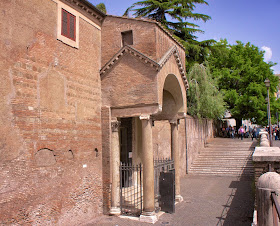On a sunny morning John and I walked down the Via Dei Fori Imperiali past buskers,
the Forum
and the Colisseum
to the amazing 12th century church of San Clemente. While John checked out the information board at the side entrance to the church,
I went around to the below street-level, 4th century Portico of the earlier church
which enters to the atrium (later a cloister) which was the original passage way to the church.
The present church built in 1108 retained the layout of an earlier 4th century church as well as the marble 6th century choir enclosure from the original church which was demolished during the 1084 Sack of Rome. That's a 12th century mosaic in the background.
This Crucifixion in the Chapel of the Passion may be by Masaccio.
Many elements of the earlier church like this pillar and its capital were re-used in the new church.
If you visit San Clemente be sure to descend below the present church to the remains of the 4th-11th century church below
with its remains of tombs and relief sculptures
This fresco commemorates the story of a boy found alive in St Clement's tomb beneath the Black Sea.
This detail shows the saved boy. You can just see his head at the bottom right of the fresco above.
This fresco of Empress Theodora, Constantine's Byzantine wife, was later turned into a Madonna with Child.
Down a third level, the dark, underground corridors reveal a pagan Temple of Mithras.
One level below that one finds a 1st century private Roman home with its own spring water still flowing after two thousand years.
























































